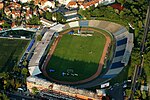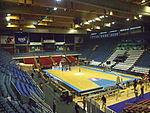Pančevo Bridge
Bridges completed in 1946Bridges in BelgradeBridges over the DanubeBuildings and structures in BelgradePalilula, Belgrade ... and 3 more
Railway bridges in SerbiaRoad-rail bridgesRoad bridges in Serbia
Pančevo Bridge (Serbian Cyrillic: Панчевачки мост, romanized: Pančevački most) or colloquially Pančevac (Serbian Cyrillic: Панчевац) is a bridge over the Danube in Belgrade, the capital of Serbia. It was named after the northern city of Pančevo (in Vojvodina) which is connected to Belgrade by the road continuing from the bridge. It was the first permanent bridge across the Danube in Belgrade, and until December 2014, when the Pupin Bridge opened further upstream in the municipality of Zemun, the only one.
Excerpt from the Wikipedia article Pančevo Bridge (License: CC BY-SA 3.0, Authors).Pančevo Bridge
Pancevo Bridge, Palilula Urban Municipality Palilula
Geographical coordinates (GPS) Address External links Nearby Places Show on map
Geographical coordinates (GPS)
| Latitude | Longitude |
|---|---|
| N 44.828 ° | E 20.492 ° |
Address
Панчевачки мост
Pancevo Bridge
11060 Palilula Urban Municipality, Palilula
Central Serbia, Serbia
Open on Google Maps







